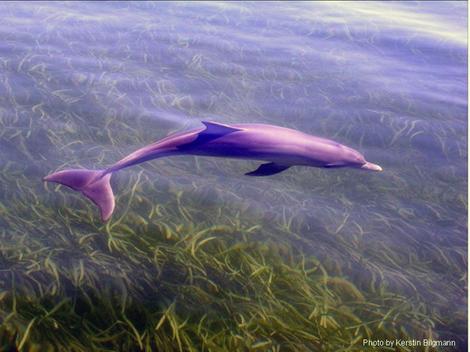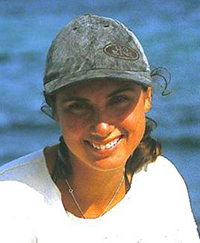
November 19, 2008

Australian scientists have discovered a previously unknown dolphin swimming in their nation’s southern waters.
Until now it had been thought the world had just two species of bottlenose dolphins. The common bottlenose, generally at home in offshore waters, and the more coastal Indo-Pacific species, are both found near Australia.
However, Macquarie and Monash university researchers, collecting genetic samples from what they thought were coastal dolphins, made an unexpected find. After DNA testing about 200 mammals off Victoria, South Australia and Tasmania for a population study, the scientists realised they were not coastal bottlenose dolphins at all.

“They look alike but they are genetically quite different,” Luciana Möller (above), of Macquarie University, said yesterday. “We were surprised.” The biologist received her PhD in Environmental Studies in 2001. She has been working in the field of cetacean behavioural ecology and mate selection for years, specifically, in Australia, 1997-2005; in the United States, 1995; in Brazil, 1990-1995; and Antarctic, 1994.
Such finds, said Dr. Möller, were “pretty rare”.
“Large mammals are not discovered very often. It shows we still have a lot to learn about how many marine species are out there. In the current biodiversity crises, when we are losing so many animal species, it is very exciting to find out about these unique Australian dolphins,” she said.
Möller suspected that the new species, and the previously known coastal bottlenose dolphins, probably separated “quite recently … in the past few million years”.
The DNA tests suggested the new species was probably more closely related to the Fraser’s dolphin, from the deep waters of the Pacific.
Möller said she believed the limited range of the new species meant it deserved special protection.
“Due to their coastal habitat, these dolphins are also more likely to face threats such as pollution, overfishing and entanglement in nets,” Möller noted.
Details of the discovery have been published in Molecular Phylogenetics And Evolution.
Reference:
Möller LM, Bilgmann K, Charlton-Robb K, Beheregaray LB (2008) Multi-gene evidence for a new species of bottlenose dolphin in southern Australia. Molecular Phylogenetics and Evolution. In press.
About Loren Coleman
Loren Coleman is one of the world’s leading cryptozoologists, some say “the” leading living cryptozoologist. Certainly, he is acknowledged as the current living American researcher and writer who has most popularized cryptozoology in the late 20th and early 21st centuries.
Starting his fieldwork and investigations in 1960, after traveling and trekking extensively in pursuit of cryptozoological mysteries, Coleman began writing to share his experiences in 1969. An honorary member of Ivan T. Sanderson’s Society for the Investigation of the Unexplained in the 1970s, Coleman has been bestowed with similar honorary memberships of the North Idaho College Cryptozoology Club in 1983, and in subsequent years, that of the British Columbia Scientific Cryptozoology Club, CryptoSafari International, and other international organizations. He was also a Life Member and Benefactor of the International Society of Cryptozoology (now-defunct).
Loren Coleman’s daily blog, as a member of the Cryptomundo Team, served as an ongoing avenue of communication for the ever-growing body of cryptozoo news from 2005 through 2013. He returned as an infrequent contributor beginning Halloween week of 2015.
Coleman is the founder in 2003, and current director of the International Cryptozoology Museum in Portland, Maine.
Filed under Cryptotourism, CryptoZoo News, Cryptozoologists, Cryptozoology, New Species